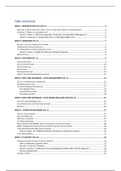Summary
Information Management Summary from all lectures and the book "Information Systems for Business and Beyond"
- Course
- Institution
- Book
All you need to know for the pre-master course Information Management at the Tilburg University. All lectures are transcribed in text in this summary and are categorised for each week as well as all the presentation slides information. All lectures and terminologies are explained in this extensive ...
[Show more]




